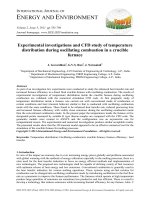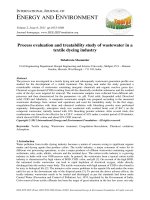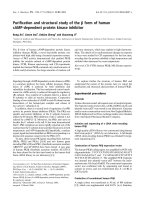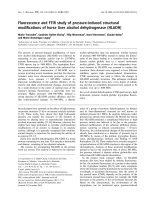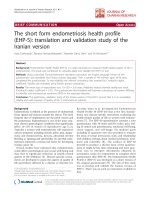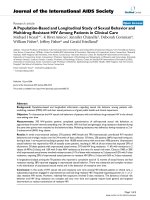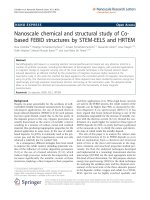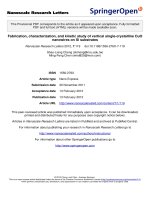Sensorial and microbial study of mushroom pickle
Bạn đang xem bản rút gọn của tài liệu. Xem và tải ngay bản đầy đủ của tài liệu tại đây (293.45 KB, 7 trang )
Int.J.Curr.Microbiol.App.Sci (2020) 9(8): 1458-1464
International Journal of Current Microbiology and Applied Sciences
ISSN: 2319-7706 Volume 9 Number 8 (2020)
Journal homepage:
Original Research Article
/>
Sensorial and Microbial Study of Mushroom Pickle
Y. Prabhabati Devi1* and Kumari Sunita2
1
Krishi Vigyan Kendra, Chandel ICAR-Manipur Centre, India
2
Krishi Vigyan Kendra Madhopur West Champaran, India
*Corresponding author
ABSTRACT
Keywords
Mushroom,
Preservatives,
Sensory, Shelf life
Article Info
Accepted:
15 July 2020
Available Online:
10 August 2020
Mushroom is one of the important sources of protein which is highly perishable. The shelf
life of the mushroom can be extended by the preserving it in the form of pickle. The main
aim of the present study is the sensorial and microbial study of mushroom pickle by
employing different technology. The products have been evaluated for sensory attribute i e
color, aroma, taste, texture and overall acceptability. The growth of fungus and changes in
appearance at different storage period were also evaluated. The results showed that
mushroom pickle stored successfully for 30 days at ambient temperature (26 ± 4◦C)
without any significant change in the quality attribute after incorporation of vinegar as a
common preservative. The result showed that preservation of mushroom with vinegar got
the highest score and also the best method for extending the shelf life by retarding the
growth of microorganism.
Introduction
Mushroom is a fleshy spore bearing fruiting
body of fungus and very nutritious natural
vegetable which contains high quality protein,
vitamins and fibre. It is widely used as
vegetables and also as a traditional medicine.
Mushroom is highly perishable and starts
deteriorating after a few hours depending
upon the storage conditions. The shelf life of
mushroom varies from 1-2 days at the
ambient temperature due to its high moisture
content, delicate texture and unique
physiology (Sexena and Rai, 1990). The shelf
life of mushroom can be extended by
converting in to value added products. The
value added products not only reduces the
post harvest losses but also enhances the
additional income to the mushroom growers
and also provide neutraceutical low fat,
protein rich food to the consumers
(Arumuganathan et al., 2005). For increasing
shelf life and also to increase the acceptability
of the customer, mushroom is processed in
the form of pickle. Pickle is a good appetizer
consumed by all age of people which contain
large amount of lactobacilli bacteria which
are important for the digestion of grains and
vegetables which have usual beneficial
probiotic properties used by the body
(Girdhari Lal et al., 2010). For pickling
proper concentration of salt is very important
for better shelf life and also to reduce the
infestation of mold, yeast and bacteria. If salt
1458
Int.J.Curr.Microbiol.App.Sci (2020) 9(8): 1458-1464
concentration is less, the product gets slimy,
soft and holds lots of water. Therefore the
average salt concentration should not be less
than 5.3 per cent (Rajablou et al., 2012).
Sensory attribute is one of the important
factors govern the consumers acceptance of
food products and their purchase intent. The
overall quality of any food product is related
to several sensory attribute like appearance,
texture and flavor. Texture is also one of the
most
important
sensorial
quantitative
characteristics of pickle and its effect on
product acceptance by the buyer is crucial
(Sadeghizadeh et al., 2018) The process of
pickle production is carried out under optimal
condition, some changes occur in the texture
of primary products which affects the quality
of pickle as reported by Rodrige and
Alvarruiz (2010).The problem of shelf life of
mushroom pickle is higher in Manipur as it is
highly perishable and hence an attempt is
made to minimize the spoilage by the proper
use of preservatives and also to select good
quality fresh mushroom. The present study
was undertaken to prepare mushroom pickle
by use of different preservatives, to observe
shelf life at different storage period, to
evaluate the fungal growth and also to assess
the overall acceptability of pickle by sensory
evaluation.
Method of preparation oyster mushroom
pickle
The recipe of the oyster mushroom pickle is
given in Table 2. Select fresh, mature
mushroom and wash thoroughly with tap
water to remove dust and dirt. Then remove
stalk and cut in to desire shape and size.
Blanch it for 3 min at a temperature 96-98º C
and drain water properly. Fry spices in oil and
add blanched mushroom and mix it properly.
For storing pickle glass jar was sterialised
at100°C and dry it properly. In some
treatment like T4 acetic acid was used and in
T5 vinegar was used. For making mushroom
pickle, mustard oil was heated and put all the
spices, fry for few seconds and added the
blanched mushroom and fry for 4-5 minutes
in low flame till it blended properly. Salt and
remaining oil were added. The fried
mushroom pickle was cooled, filled in to
sterilized glass bottle and sealed airtight. The
flow chart for the preparation of mushroom
pickle was shown in figure 1. For treatment
like T4 acetic acid was added just before
removing from fire and in case of T5,
blanched mushroom was cured in vinegar for
4 hrs and drain vinegar water and other
process remain same with other treatments.
Results and Discussion
Materials and Methods
The fresh, healthy oyster mushrooms were
collected from Imphal market and other
ingredients like spices, oil, acetic acid and
vinegar were also collected from the local
market. The experiment was conducted for a
period of one year. Observation was recorded
at the end of every month for the period of
2month and at 2 month interval for the period
up to12 month in order to see any change in
colour, aroma, texture and appearance of
fungus. Method of collection of sample along
with treatment was shown in Table 1.
Sensory evaluation of oyster mushroom
pickle
The consumer’s acceptability of processed
mushroom pickle was evaluated by a taste
testing panel. The hedonic rating test was
used to determine the acceptability of pickle.
The 30 panelists were selected from women
entrepreneur of Imphal, Manipur. Panelists
were asked to give scores for characteristic
color, aroma, texture, taste and overall
acceptability of the processed mushroom
pickle. The scale was arranged such that 9 =
like extremely, 8 = like very much, 7 = like
1459
Int.J.Curr.Microbiol.App.Sci (2020) 9(8): 1458-1464
moderately, 6 = like slightly, 5 = neither like
or dislike, 4 = Dislike slightly, 3 = Dislike
moderately, 2 = Dislike very much, 1 =
Dislike extremely.
The mean score of performance mushroom
pickles were presented in Table 5. From the
table, it is seen that T5 secured the highest
score: 8.0 for colour, 7.8 for aroma, 7.8 for
texture, for taste 8.2 and 8.0 for overall
acceptability and was ranked 8 (like very
much).
It also showed that T1 got the lowest value
than the other sample.T5 got the highest value
which indicated that color, aroma texture,
taste of T5 is more acceptable than the others.
Observation of fungus growth
The fungal growth developed in mushroom
pickle at different storage period was
examined through visual observation. Details
of the observation were given in Table 3. Up
to 30 days storage, no fungal growth was
observed. During 2nd month of storage, the
fungal growth was observed inT1 due to low
concentration of salt and mustard oil. Whitish
fungal growth was observed on the surface of
the pickle, it may be due to spices, other
ingredients, from the air or from lid of the jar.
From 6th months to 12 months, excessive
growth of fungus was observed in case of T1
and T2 and other treatments like T3 there was
slight growth by fungus from 8th months
onwards.
Table.1 Method of selection of sample with different treatment
Sample
Sample 1
Sample 2
Sample 3
Sample 4
Sample 5
Treatment
Blanched oyster mushroom +3.5per cent salt + spice + 15per cent mustard oil and store in
sterialised glass bottle
Blanched oyster mushroom + 5per cent salt + spice + 20per cent mustard oil and store in
sterialised glass bottle
Blanched oyster mushroom + 6per cent salt + spice + 25per cent mustard oil and store in
sterialised glass bottle
Blanched oyster mushroom+ 8per cent salt + spice + 30 per cent mustard oil + 1.5 per
cent Acetic acid and store in sterialised glass bottle
Vinegar cured blanched oyster mushroom +10per cent salt + spice+35per cent mustard
oil and store in sterialised glass bottle
Table.2 Recipe of oyster mushroom pickle
Ingredients
Blanched oyster mushroom (kg)
Mustard Oil (ml)
Salt (g)
Chilli Powder (g)
Jira Powder(g)
White Mustard Seed Powder(g)
Coriander Powder (g)
Turmeric Powder (g)
Vinegar
Acetic Acid
T1
1
100
30
10
10
10
5
10
-
1460
Treatments
T2
T3
1
1
150
200
50
60
20
30
10
10
15
20
10
10
15
20
-
T4
1
250
80
35
10
20
10
20
25ml
T5
1
300
100
40
10
20
10
20
1 lt
-
Int.J.Curr.Microbiol.App.Sci (2020) 9(8): 1458-1464
Table 3 Visual observation of fungus growth developed in oyster mushroom pickle at different
storage period
Storage
Period
(Month)
1month
Sample
Fungal Growth
S1
S2
S3
S4
S5
S1
S2
S3
S4
S5
S1
S2
S3
S4
S5
S1
S2
S3
S4
S5
2month
4 month
6 month
Storage Period
(Month)
No Growth
No Growth
No Growth
No Growth
No Growth
Slightly Growth
No Growth
No Growth
No Growth
No Growth
Slightly Growth
Slightly Growth
No Growth
No Growth
No Growth
Excessive Growth
Slightly Growth
No Growth
No Growth
No Growth
8 month
10 month
12 month
Sample
Fungal Growth
S1
S2
S3
S4
S5
S1
S2
S3
S4
S5
S1
S2
S3
S4
S5
Excessive
Growth
Excessive
Growth
Slightly Growth
Excessive
Growth
Excessive
Growth
Slightly growth
Excessive
Growth
Excessive
Growth
Excessive
Table.4 Storage life of oyster mushroom pickle
Shelf life
(months)
1
2
4
6
Sample
S1
S2
S3
S4
S5
S1
S2
S3
S4
S5
S1
S2
S3
S4
S5
S1
S2
Colour
No change
No change
No change
No change
No change
Slightly change
No change
No change
No change
No change
Change
Slightly change
No change
No change
Change
Change
Flavour
Texture
No off flavour
No off flavour
No off flavour
No off flavour
No off flavour
Slightly off flavour
No off flavour
No off flavour
No off flavour
No off flavour
Off flavour
Slightly off flavour
No off flavour
No off flavour
No off flavour
Off flavour
Off flavour
Firm
Firm
Firm
Firm
Firm
Slightly soft
Firm
Firm
Firm
Firm
Soft
Slightly soft
Firm
Firm
Firm
Extremely soft
Soft
1461
Remark
Good
Good
Good
Good
Good
Fair
Good
Good
Good
Good
Slightly spoiled
Fair
Good
Good
Good
Spoiled
Slightly spoiled
Int.J.Curr.Microbiol.App.Sci (2020) 9(8): 1458-1464
8
10
12
S3
S4
S5
S1
S2
S3
S4
S5
S1
S2
S3
S4
S5
S1
S2
S3
S4
S5
Slightly change
No change
No change
Change
Change
Change
No change
No change
Change
Change
Change
Slightly change
No change
Change
Change
Change
Change
No change
Slightly off flavour
No off flavour
No off flavour
Off flavour
Off flavour
Off flavour
No off flavour
No off flavour
Off flavour
Off flavour
Off flavour
Slightly off flavour
No off flavour
Off flavour
Off flavour
Off flavour
Off flavour
No off flavour
Slightly Soft
Firm
Firm
Extremely soft
Extremely soft
Soft
Firm
Firm
Extremely soft
Extremely soft
Extremely soft
Soft
Firm
Extremely soft
Extremely soft
Extremely soft
Soft
Firm
Fig.1 Flow chart for the preparation of mushroom pickle
Treatment – 1
Select fresh and healthy oyster mushroom
Remove stalk and wash to remove dust
Cut in to pieces and blanched for 3mins
Washed with cold water and strained water
Fry spices in oil
Add blanched mushroom to fried spices
Add salt and fry the mixture for about 10 minutes
Cool and fill in sterilized jar
Seal and store in cool dry place
1462
Fair
Good
Good
Completely spoiled
Spoiled
Slightly spoiled
Good
Good
Completely spoiled
Spoiled
Spoiled
Slightly spoiled
Good
Completely spoiled
Completely spoiled
Spoiled
Slightly spoiled
Good
Int.J.Curr.Microbiol.App.Sci (2020) 9(8): 1458-1464
Table.5 Mean score for performance of colour aroma, texture, taste and overall acceptability of
various sample of oyster mushroom pickle
Sample
Code
S1
S2
S3
S4
S5
Colour
7.1
7.3
7.5
7.7
8.0
Sensory attributes
Texture
Taste
7. 0
6.5
7.3
6.8
7.5
7.0
7.5
7.5
7.8
8.2
Aroma
6.5
6.5
6.8
7.2
7.8
In case treatment like T4 fungal growth started
from 10 months onwards and in case of T5,
there was no fungal appearance on the surface
of the pickle due to high concentration of salt,
mustard, acetic acid and vinegar. The covering
of oil as well as proper concentration of salt
helped to prevent microbial contamination and
vinegar and acetic acid helped to maintain the
proper pH of the pickle.
Storage studies of oyster mushroom pickle
Mushroom pickles were stored at room
temperature. The deterioration of the product
was observed at a regular interval of one
month upto 2 months and 2 months interval
for a period upto 12 months. The change in
color, aroma and texture were observed for a
period of 1 year. Five different samples of
mushroom pickles were used for storage
studies at room temperature of 260 – 300 C
from 1 month to 12 months. The effect of
storage time on physical properties such as
colour, aroma and texture of the pickles were
studied. The processed mushroom pickles
were in good condition up to 30 days in case
of T1 and in case of T5, it was up to 12
months. For T1 and T2 change in color,
flavour and texture started from 2th and 4th
months onwards which was shown in Table 4.
This may be due to lack of proper
concentration of preservatives like salt and
mustard oil. In case of T3, changes started
from 6 months onwards and for T4, changes
of colour, texture and appearance started from
10 months onwards
Overall acceptability
6.6
6.8
7.2
7.5
8.0
due to lack of right concentration of
preservatives like vinegar and acetic acid. For
T5, there was no change in color, flavour and
texture up to 12 months as the blanched bitter
mushroom was cured in vinegar for 4 hours
and right concentration of salt and mustard oil
were added which helped to extend the shelf
life up to 12 months.
In conclusion the mushroom pickle is highly
perishable. So, proper preservatives like salt,
mustard oil, acetic acid and vinegar should be
used in proper concentration to reduce the
microbial growth and also to extend the shelf
life of the pickle. From this study, it was
found that fungal growth was a great problem
of pickle. If we add proper concentration of
preservatives, the fungal growth becomes
very low. The panelists also tested the product
and gave the score for color, aroma, texture,
taste and overall acceptability. The score of
panel test indicated that among the five
treatments, the pickle which was prepared
with vinegar cured blanched mushroom (T5)
was the most acceptable. In case of shelf life,
T5 have better shelf life than other 4
treatment. It was proved thatT5 is the best
method for extending the shelf life and also
for improving the quality of the mushroom
pickle. This study gives a good prospect on
processing of mushroom. This technology
may be adopted on large scale by the rural
youth, women entrepreneurs and farm women
in order to generate income and also for
increasing employment opportunity for
sustaining livelihood.
1463
Int.J.Curr.Microbiol.App.Sci (2020) 9(8): 1458-1464
References
Arumuganathan, T, R.D. Rai and A.K.
Hemakar
(2005)
‘Studies
on
development of value added products
from fresh button mushroom Agaricus
bisporus’. Mushroom Research 14(2)
Goel, A. K., Kumar, R. and Mann, S. S.
(2007). Postharvest Management and
Value Addition. Daya Publishing
House, Trinagar, New Delhi - 110 035.
Girdhari, L. and Siddapa, G. S. (2010)
Chutney, sauce, pickle, preservation of
fruits
and
vegetables.
ICAR
Publications, New Delhi.
Rajablou et at. (2012) Make pickles probiotic
with using strain Lactobacillus
plantanum native. Journal of Food
Technology and Nutrition. 9(2).
Rodrigo, M and Alvarruiz, A (2010) The
influence
of
fermentation
and
pasteurization on the texture of
cucumber pickle. Journal of Food
Engineering, 7(2)
Sadeghizadeh, Yazdi. J., Behradkia, V.,
Hozoori, M. (2018) ‘Evaluation of
sensorial, chemical and microbial
characteristic of pickled cucumber
supplied in Shiraz’. Journal of
Nutrition and Food Security, 3 (2).
Sangeeta. A., Pingale and Vaibhav, R.,
Dabhade. (2015) ‘Development and
sensory attributes of the pickle made
from Bitter gourd and Bottle gourd’.
Int J Sci Res, Vol (4) Issue 10.
Saxena, S and R.D. Rai (1990). ‘Post Harvest
Technology of Mushroom’. Technical
Bulletin No.2. NRCM, Solan, India
Shahzor, G. K. and Wen, Z. (2015) ‘Effects of
processing techniques on the quality
and acceptability of Auricularia
auricular Mushroom pickle’. Journal
of Food and Nutrition Research 3(1)
Srivastava, R. P. and Kumar, S. (2003) Fruit
and Vegetable Preservation. Indian
Food Packer, Lucknow.
How to cite this article:
Prabhabati Devi, Y. and Kumari Sunita. 2020. Sensorial and Microbial Study of Mushroom
Pickle. Int.J.Curr.Microbiol.App.Sci. 9(08): 1458-1464.
doi: />
1464
